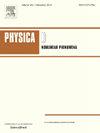影响网络重建从离散时间序列的计数数据建模的多维霍克斯过程
IF 2.7
3区 数学
Q1 MATHEMATICS, APPLIED
引用次数: 0
摘要
在没有已知先验网络结构的情况下,从时间序列数据中识别关键影响因素,在从犯罪分析到社交媒体的各种应用中都是一个具有挑战性的问题。虽然很多工作都集中在基于事件的时间序列(时间戳)数据上,但很少有方法处理计数数据,其中事件计数以固定的间隔记录。我们开发了批处理和顺序计数数据的网络推理方法。在这里,强网络连接代表了节点之间的关键影响。我们介绍了一种基于集成的算法,植根于期望最大化(EM)框架,并展示了其通过离散时间Cox或Hawkes过程识别节点动态和连接的实用性。对于线性多维Hawkes模型,我们采用最小化-最大化(MM)方法,允许网络的并行推理。对于顺序推理,我们使用贝叶斯推理问题的二阶近似。在某些假设下,对协方差矩阵进行rank-1更新可以减少计算成本。我们在合成数据和真实世界的数据集上验证我们的方法,包括欧洲学术界的电子邮件通信。我们的方法有效地重建了底层网络,同时考虑了激励和扩散的影响。这项工作推进了现实场景中计数数据的网络重建。本文章由计算机程序翻译,如有差异,请以英文原文为准。
Influence network reconstruction from discrete time-series of count data modelled by multidimensional Hawkes processes
Identifying key influencers from time series data without a known prior network structure is a challenging problem in various applications, from crime analysis to social media. While much work has focused on event-based time series (timestamp) data, fewer methods address count data, where event counts are recorded in fixed intervals. We develop network inference methods for both batched and sequential count data. Here the strong network connection represents the key influences among the nodes. We introduce an ensemble-based algorithm, rooted in the expectation–maximization (EM) framework, and demonstrate its utility to identify node dynamics and connections through a discrete-time Cox or Hawkes process. For the linear multidimensional Hawkes model, we employ a minimization–majorization (MM) approach, allowing for parallelized inference of networks. For sequential inference, we use a second-order approximation of the Bayesian inference problem. Under certain assumptions, a rank-1 update for the covariance matrix reduces computational costs. We validate our methods on synthetic data and real-world datasets, including email communications within European academic communities. Our approach effectively reconstructs underlying networks, accounting for both excitation and diffusion influences. This work advances network reconstruction from count data in real-world scenarios.
求助全文
通过发布文献求助,成功后即可免费获取论文全文。
去求助
来源期刊

Physica D: Nonlinear Phenomena
物理-物理:数学物理
CiteScore
7.30
自引率
7.50%
发文量
213
审稿时长
65 days
期刊介绍:
Physica D (Nonlinear Phenomena) publishes research and review articles reporting on experimental and theoretical works, techniques and ideas that advance the understanding of nonlinear phenomena. Topics encompass wave motion in physical, chemical and biological systems; physical or biological phenomena governed by nonlinear field equations, including hydrodynamics and turbulence; pattern formation and cooperative phenomena; instability, bifurcations, chaos, and space-time disorder; integrable/Hamiltonian systems; asymptotic analysis and, more generally, mathematical methods for nonlinear systems.
 求助内容:
求助内容: 应助结果提醒方式:
应助结果提醒方式:


